The Long-Term Performance of a High-Density Polyethylene Geomembrane with Non-Parametric Statistic Analysis and Its Contribution to the Sustainable Development Goals
Abstract
:1. Introduction
2. Geomembranes and Sustainability
3. Case of Study
3.1. Materials
3.2. Field Exposure Conditions
4. Tests Methods
4.1. Density
4.2. Thickness
4.3. Tensile Tests
4.4. Tear Resistance
4.5. Puncture Resistance
4.6. Carbon Black
4.7. Stress Crack Resistance (SCR)
4.8. Integrity of the Seams
4.9. Oxidative Induction Time (OIT) Tests
5. Test Results
6. Discussion
7. Conclusions
- The geomembrane exposed showed antioxidant depletion, but considering the average residual values of Std-OIT and HP-OIT for HDPE geomembranes from the literature [30,31,35,83], it is possible that there are still antioxidant stabilizers to be consumed (first stage of degradation) for SP1. SP2 and especially SP3 could be very close to, or have already reached, their residual values.
- After 11 years of exposure, the SCR values of SP2 and SP3 had decreased to 40 and 32% of the reference value [45], implying that the material had reached nominal failure.
- The probability of the geomembrane reaching nominal failure was 0.4% as a function of tensile strength, which translates to a 99.6% probability of success.
- The peel separation showed values higher than the maximum values allowable [45]. Environmental analyses indicated no significant contamination in the area.
- The geomembrane used in this scenario contributed to SDG 3 (Good Health and Well-Being), SDG 6 (Clean Water and Sanitation), SDG 15 (Life on Land), and SDG 13 (Climate Action).
Author Contributions
Funding
Institutional Review Board Statement
Informed Consent Statement
Data Availability Statement
Acknowledgments
Conflicts of Interest
References
- Pinto, G.E.; Pires, A.; Georges, M.R.R. Anthropocene and climate change: The perception and awareness of Brazilians according to the IBOPE survey. Desenvolv. Meio Ambiente 2020, 54, 1–25. [Google Scholar] [CrossRef]
- Thomas, L.; Tang, H.; Kalyon, D.M.; Aktas, S.; Arthur, J.D.; Blotevogel, J.; Carey, J.W.; Filshill, A.; Fu, P.; Hsuan, G.; et al. Toward better hydraulic fracturing fluids and their application in energy production: A review of sustainable technologies and reduction of potential environmental impacts. J. Pet. Sci. Eng. 2019, 173, 793–803. [Google Scholar] [CrossRef]
- Zhu, Y.; Zhang, F.; Jia, S. Embodied energy and carbon emissions analysis of geosynthetic reinforced soil structures. J. Clean. Prod. 2022, 370, 133510. [Google Scholar] [CrossRef]
- Palmeira, E.M.; Araújo, G.L.S.; Santos, E.C.G. Sustainable Solutions with Geosynthetics and Alternative Construction Materials—A Review. Sustainability 2021, 13, 12756. [Google Scholar] [CrossRef]
- Raja, J.; Dixon, N.; Fowmes, G.; Frost, M.; Assinder, P. Obtaining reliable embodied carbon values for geosynthetics. Geosynth. Int. 2015, 22, 393–401. [Google Scholar] [CrossRef]
- Slaymane, R.A.; Solimen, M.R. Integrated water balance and water quality management under future climate change and population growth: A case study of Upper Litani Basin, Lebanon. Clim. Chang. 2022, 172, 28. [Google Scholar] [CrossRef]
- Mousavi, S.H.; Kavianpour, M.R.; Alcaraz, J.L.G.; Yamini, O.A. System Dynamics Modeling for Effective Strategies in Water Pollution Control: Insights and Applications. Appl. Sci. 2023, 13, 9024. [Google Scholar] [CrossRef]
- Buber, A.; Bolgov, M.; Buber, V. Statistical and Water Management Assessment of the Impact of Climate Change in the Reservoir Basin of the Volga–Kama Cascade on the Environmental Safety of the Lower Volga Ecosystem. Appl. Sci. 2023, 13, 4768. [Google Scholar] [CrossRef]
- Schussel, Z.G.L. Sustainable urban development—A possible utopia? Desenvolv. Meio Ambiente 2004, 9, 57–67. [Google Scholar] [CrossRef]
- Leite, A.C.C.; Alves, E.E.C.; Picchi, L. The multilateral climate cooperation and the promotion of the energy transition agenda in Brazil. Desenvolv. Meio Ambiente 2020, 54, 379–403. [Google Scholar] [CrossRef]
- Dixon, N.; Fowmes, G.; Frost, M. Global challenges, geosynthetic solutions and counting carbon. Geosynth. Int. 2017, 24, 451–464. [Google Scholar] [CrossRef]
- Le Blanc, D. Towards Integration at Last? The Sustainable Development Goals as a Network of Targets. Sustain. Dev. 2015, 23, 176–187. [Google Scholar] [CrossRef]
- Cenci, D.R. Sociopolitical and Environmental Conflicts in the Brazilian Context: Before and After Rio 92, Environmental Policies and the Contribution to Latin American Geopolitics. Estud. Av. 2018, 30, 23–49. [Google Scholar]
- Lim, M.M.L.; Jorgensen, P.S.; Wyborn, C.A. Reframing the sustainable development goals to achieve sustainable development in the Anthropocene—A systems approach. Ecol. Soc. 2018, 23, 22. [Google Scholar] [CrossRef]
- Touze, N. Healing the world: A geosynthetics solution. Geosynth. Int. 2021, 28, 1–31. [Google Scholar] [CrossRef]
- Gutiérrez-Diez, J.C.; Castañón, A.M.; Bascompta, M. New Method to Study the Effectiveness of Mining Equipment: A Case Study of Surface Drilling Rigs. Appl. Sci. 2024, 14, 2185. [Google Scholar] [CrossRef]
- Tao, Y.; Zhang, R. An Integrated Decision Support System for Low-Disturbance Surface Mining. Appl. Sci. 2024, 14, 1672. [Google Scholar] [CrossRef]
- Trovão, J.; Soares, F.; Paiva, D.S.; Pratas, J.; Portugal, A. A Snapshot of the Microbiome of a Portuguese Abandoned Gold Mining Area. Appl. Sci. 2024, 14, 226. [Google Scholar] [CrossRef]
- Windisch, J.; Gradwohl, A.; Gilbert, B.M.; Dos Santos, Q.M.; Wallner, G.; Avenant-Oldewage, A.; Jirsa, F. Toxic Elements in Sediment and Water of the Crocodile River (West) System, South Africa, Following Acid Mine Drainage. Appl. Sci. 2022, 12, 10531. [Google Scholar] [CrossRef]
- Besedin, J.A.; Khudur, L.S.; Netherway, P.; Ball, A.S. Remediation Opportunities for Arsenic-Contaminated Gold Mine Waste. Appl. Sci. 2023, 13, 10208. [Google Scholar] [CrossRef]
- Ba, N.B.; Souissi, R.; Manai, F.; Taviche, I.K.; Bejaoui, B.; Bagga, M.A.; Souissi, F. Mineralurgical and Environmental Characterization of the Mine Tailings of the IOCG Mine of Guelb Moghrein, Akjoujt, Mauritania. Appl. Sci. 2024, 14, 1591. [Google Scholar] [CrossRef]
- American Society for Testing and Materials. Standard Terminology for Geosynthetics; American Society for Testing and Materials: West Conshohocken, PA, USA, 2024. [Google Scholar]
- Müller, W.W.; Saathoff, F. Geosynthetics in geoenvironmental engineering. Sci. Technol. Adv. Mater. 2015, 16, 034605. [Google Scholar] [CrossRef] [PubMed]
- Mounes, S.M.; Karim, M.R.; Khodaii, A.; Almasi, M.H. Improving Rutting Resistance of Pavement Structures Using Geosynthetics: An Overview. Sci. World J. 2014, 2014, 764218. [Google Scholar] [CrossRef]
- Markiewicz, A.; Koda, E.; Kawalec, J. Geosynthetics for Filtration and Stabilization: A Review. Polymers 2022, 14, 5492. [Google Scholar] [CrossRef]
- Brandl, H. Geosynthetics applications for the mitigation of natural disasters and for environmental protection. Geosynth. Int. 2011, 18, 340–390. [Google Scholar] [CrossRef]
- Zhang, Y.; Kinoshita, Y.; Kato, T.; Takai, A.; Katsumi, T. Attenuation performance of geosynthetic sorption sheets against arsenic subjected to compressive stresses. Geotext. Geomembr. 2023, 51, 179–190. [Google Scholar] [CrossRef]
- Giroud, J.P.; Bonaparte, R. Leakage through Liners Constructed with Geomembrane—Part I. Geomembrane Liners. Geotext. Geomembr. 1989, 8, 27–67. [Google Scholar] [CrossRef]
- Rowe, R.K.; Sangam, H.P. Durability of HDPE geomembranes. Geotext. Geomembr. 2002, 20, 77–95. [Google Scholar] [CrossRef]
- Ewais, A.M.R.; Rowe, R.K.; Scheirs, J. Degradation behaviour of HDPE geomembranes with high and low initial high-pressure oxidative induction time. Geotext. Geomembr. 2014, 42, 111–126. [Google Scholar] [CrossRef]
- Rowe, R.K.; Ewais, A.M.R. Ageing of exposed geomembranes at locations with different climatological conditions. Can. Geotech. J. 2014, 52, 326–343. [Google Scholar] [CrossRef]
- Hsuan, Y.G.; Koerner, R.M. Antioxidant depletion lifetime in high density polyethylene geomembranes. J. Geotech. Geoenviron. Eng. 1998, 124, 532–541. [Google Scholar] [CrossRef]
- Rowe, R.K.; Abdelaal, F.B.; Brachman, R.W.I. Antioxidant depletion of HDPE geomembrane with sand protection layer. Geosynth. Int. 2013, 20, 73–89. [Google Scholar] [CrossRef]
- Ewais, A.M.R.; Rowe, R.K.; Rimal, S.; Sangam, H.P. 17-year elevated temperature study of HDPE geomembrane longevity in air, water and leachate. Geosynth. Int. 2018, 25, 525–544. [Google Scholar] [CrossRef]
- Rowe, R.K.; Rimal, S.; Sangam, H. Ageing of HDPE geomembrane exposed to air, water and leachate at different temperatures. Geotext. Geomembr. 2009, 27, 137–151. [Google Scholar] [CrossRef]
- Hsuan, Y.G.; Schroeder, H.F.; Rowe, R.K.; Müller, W.; Greenwood, J.; Cazzuffi, D.; Koerner, R.M. Long-term performace and lifetime prediction of geosynthetics. In Proceedings of the EuroGeo4 Keynote Paper, Edinburgh, UK, 7–10 September 2008. [Google Scholar]
- Koerner, R.M.; Hsuan, Y.; Lord, A.E., Jr. Remaining technical barriers to obtaining general acceptance of geosynthetics. Geotext. Geomembr. 1993, 12, 1–52. [Google Scholar] [CrossRef]
- Müller, W.W.; Jakob, I.; Li, C.S.; Tatzky-Gerth, R. Durability of polyolefin geosynthetic drains. Geosynth. Int. 2009, 16, 28–42. [Google Scholar] [CrossRef]
- Scholz, P.; Putna-Nimane, I.; Barda, I.; Liepina-Leimane, I.; Strode, E.; Kileso, A.; Esiukova, E.; Chubarenko, B.; Purina, I.; Simon, F.-G. Environmental Impact of Geosynthetics in Coastal Protection. Materials 2021, 14, 634. [Google Scholar] [CrossRef] [PubMed]
- Sarsby, R.W. Geosynthetics in Civil Engineering; Woodhead Publishing Limited: Cambridge, UK, 2007. [Google Scholar]
- Koerner, R.M. Designing with Geosynthetics, 4th ed.; Prentice Hall: Upper Saddle River, NJ, USA, 2005. [Google Scholar]
- Koerner, R.M.; Hsuan, Y.G.; Koerner, G.R. Lifetime predictions of exposed geotextiles and geomembranes. Geosynth. Int. 2017, 24, 198–212. [Google Scholar] [CrossRef]
- Clinton, M.; Rowe, R.K. Long-term durability of two HDPE geomembranes formulated with polyethylene of raised temperature resistance (PE-RT). Geotext. Geomembr. 2024, 52, 304–318. [Google Scholar] [CrossRef]
- Rowe, R.K.; Shoaib, M. Effect of brine on long-term performance of four HDPE geomembranes. Geosynth. Int. 2017, 24, 508–523. [Google Scholar] [CrossRef]
- GRI GM13; Test Methods, Test Properties and Testing Frequency for High Density Polyethylene (HDPE) Smooth and Textured Geomembranes. Geosynthetic Research Institute: Folsom, PA, USA, 2024.
- Rowe, R.K.; Islam, M.Z.; Hsuan, Y.G. Leachate chemical composition effects on OIT depletion in an HDPE geomembrane. Geosynth. Int. 2008, 15, 136–151. [Google Scholar] [CrossRef]
- Lin, B.-H.; Yu, Y.; Bathurst, R.J.; Liu, C.-N. Deterministic and probabilistic prediction of facing deformations of geosynthetic-reinforced MSE walls using a response surface approach. Geotext. Geomembr. 2016, 44, 813–823. [Google Scholar] [CrossRef]
- Gilson-Beck, A. Controlling leakege through installed geomembranes using eletrical leak location. Geotext. Geomembr. 2019, 4, 697–710. [Google Scholar] [CrossRef]
- Akis, E.; Guven, G.; Loftfisadigh, B. Predictive models for mechanical properties of expanded polystyrene (EPS) geofoam using regression analysis and artificial neural networks. Neural Comput. Appl. 2022, 34, 10845–10884. [Google Scholar] [CrossRef]
- Agarwal, E.; Pain, A. Reliability assessment of reinforced slopes with unknown probability distribution. Geosynth. Int. 2023, 30, 337–349. [Google Scholar] [CrossRef]
- Chehade, H.Á.; Guo, X.; Dias, D.; Sadek, M.; Jenk, O.; Chehade, F.H. Reliability analysis for internal seismic stability of geosynthetic-reinforced soil walls. Geosynth. Int. 2023, 30, 296–314. [Google Scholar] [CrossRef]
- Ferreira, F.B.; Gomes, A.T.; Vieira, C.S.; Lopes, M.L. Reliability analysis of geosynthetic-reinforced steep slopes. Geosynth. Int. 2016, 23, 301–315. [Google Scholar] [CrossRef]
- Liu, H.; Zheng, J.; Zhang, R.; Xie, P. Probabilistic stability analysis of reinforced soil slope with non-circular RLEM. Geosynth. Int. 2023, 30, 432–448. [Google Scholar] [CrossRef]
- Abdelaal, F.B.; Rowe, R.K.; Morsy, M.S.; Silva, R.A. Deagradation of HDPE, LLDPE, and blended polyethylene geomembranes in extremely low and high pH mining solutions at 85 °C. Geotext. Geomembr. 2023, 51, 27–38. [Google Scholar] [CrossRef]
- International Geosynthetics Society. Guide to the Specification of Geosynthetics; International Geosynthetics Society: Jupiter, FL, USA, 2019. [Google Scholar]
- Heerten, G. Reduction of climate-damaging gases in geotechnical engineering practice using geosynthetics. Geotext. Geomembr. 2011, 30, 43–49. [Google Scholar] [CrossRef]
- Troost, G.H.; den Hoedt, G.; Risseeuw, P.; Voskamp, W.; Schmidt, H.M. Durability of a 13-Year Old Test Embankment Reinforced with Polyester Woven Fabric. In Proceedings of the Fifth International Conference on Geotextiles, Geomembranes and Related Products, Singapore, 5–9 September 1994. [Google Scholar]
- Buckley, J.; Gates, W.P.; Gibbs, D.T. Forensic examination of field GCL performance in landfill capping and mining containment applications. Geotext. Geomembr. 2012, 33, 7–14. [Google Scholar] [CrossRef]
- Leshchinsky, B.; Berg, R.; Liew, W.; Kawakami-Selin, M.; Moore, J.; Brown, S.; Kleutsch, B.; Glover-Cutter, K.; Wayne, M. Characterization of geogrid mechanical and chemical properties from a thirty-six year old mechanically-stabilized earth wall. Geotext. Geomembr. 2020, 48, 793–801. [Google Scholar] [CrossRef]
- Kiersnowska, A.; Fabianowski, W.; Koda, E. The Influence of the Accelerated Aging Conditions on the Properties of Polyolefin Geogrids Used for Landfill Slope Reinforcement. Polymers 2020, 12, 1874. [Google Scholar] [CrossRef]
- Rarison, R.F.M.; Mbonimpa, M.; Bussière, B.; Pouliot, S. Properties of HDPE Geomembrane Exhumed 20 Years After Installation in a Mine Reclamation Cover System. Int. J. Geosynth. Ground Eng. 2023, 9, 1. [Google Scholar] [CrossRef]
- Peggs, I.D. Destructive Testing of Polyethylene Geomembrane Seams: Various Methods to Evaluate Seam Strength. Geotext. Geomembr. 1990, 9, 405–414. [Google Scholar] [CrossRef]
- Gulec, S.B.; Benson, C.H.; Edil, T.B. Effect of Acidic Mine Drainage on the Mechanical and Hydraulic Properties of Three Geosynthetics. J. Geotech. Geoenviron. Eng. 2005, 131, 937–950. [Google Scholar] [CrossRef]
- Kaniki, A.T.; Tumba, K. Management of mineral processing tailings and metallurgical slags of the Congolese copperbelt: Environmental stakes and perspectives. J. Clean. Prod. 2018, 210, 1406–1413. [Google Scholar] [CrossRef]
- Clemente, J.S.; Huntsman, P. Potential climate change effects on the geochemical stability of waste and mobility of elements in receiving environments for Canadian metal mines south of 60 °N. Environ. Rev. 2019, 27, 478–518. [Google Scholar] [CrossRef]
- de Souza Neto, H.F.; da Silveira Pereira, W.V.; Dias, Y.N.; de Souza, E.S.; Teixeira, R.A.; de Lima, M.W.; Ramos, S.J.; do Amarante, C.B.; Fernandes, A.R. Environmental and human health risks of arsenic in gold mining areas in the eastern Amazon. Environ. Pollut. 2020, 265, 114969. [Google Scholar] [CrossRef]
- Doku, E.T.; Belford, E.J.D. Effect of heavy metals and physicochemical parameters on diversity of plants at a gold mine tailings dam in Ghana. J. Ecol. Nat. Environ. 2022, 14, 98–108. [Google Scholar] [CrossRef]
- Muñoz, J.M. Carbon foorprint of HDPE geomembrane vs. traditional waterproofing barrier. In Proceedings of the 12th International Conference on Geosynthetics, Rome, Italy, 17–21 September 2023. [Google Scholar]
- Brazilian Association of Technical Standards. Solid Waste—Classification; Brazilian Association of Technical Standards: Sao Paulo, Brazil, 2004. [Google Scholar]
- ASTM D792; Standard Test Methods for Density and Specific Gravity (Relative Density) of Plastics by Displacement. American Society for Testing and Materials: West Conshohocken, PA, USA, 2020.
- ASTM D5199; Standard Test Method for Measuring the Nominal Thickness of Geosynthetics. American Society for Testing and Materials: West Conshohocken, PA, USA, 2019.
- ASTM D6693/D6693M; Standard Test Method for Determining Tensile Properties of Nonreinforced Polyethylene and Nonreinforced Flexible Polypropylene Geomembranes. American Society for Testing and Materials: West Conshohocken, PA, USA, 2020.
- ASTM D1004; Standard Test Method for Tear Resistance (Graves Tear) of Plastic Film and Sheeting. American Society for Testing and Materials: West Conshohocken, PA, USA, 2021.
- ASTM D4833/D4833M; Standard Test Method for Index Puncture Resistance of Geomembranes and Related Products. American Society for Testing and Materials: West Conshohocken, PA, USA, 2020.
- ASTM D4218; Standard Test Method for Determination of Carbon Black Content in Polyethylene Compounds by the Muffle-Furnace Technique. American Society for Testing and Materials: West Conshohocken, PA, USA, 2020.
- ASTM D5596; Standard Test Method for Microscopic Evaluation of the Dispersion of Carbon Black in Polyolefin Geosynthetics. American Society for Testing and Materials: West Conshohocken, PA, USA, 2021.
- ASTM D5397; Standard Test Method for Evaluation of Stress Crack Resistance of Polyolefin Geomembranes Using Notched Constant Tensile Load Test. American Society for Testing and Materials: West Conshohocken, PA, USA, 2020.
- ASTM D6392; Standard Test Method for Determining the Integrity of Nonreinforced Geomembrane Seams Produced Using Thermo-Fusion Methods. American Society for Testing and Materials: West Conshohocken, PA, USA, 2023.
- ASTM D3895; Standard Test Method for Oxidative-Induction Time of Polyolefins by Differential Scanning Calorimetry. American Society for Testing and Materials: West Conshohocken, PA, USA, 2019.
- ASTM D5885/D5885M; Standard Test Method for Oxidative Induction Time of Polyolefin Geosynthetics by High-Pressure Differential Scanning Calorimetry. American Society for Testing and Materials: West Conshohocken, PA, USA, 2020.
- ASTM D8117; Standard Test Method for Oxidative Induction Time of Polyolefin Geosynthetics by Differential Scanning Calorimetry. American Society for Testing and Materials: West Conshohocken, PA, USA, 2021.
- GRI GM19a; Seam Strength and Related Properties of Thermally Bonded Homogeneous Polyolefin Geomembranes/Barriers. Geosynthetic Research Institute: Folsom, PA, USA, 2021.
- Rowe, R.K.; Islam, M.Z.; Hsuan, Y.G. Effects of Thickness on the Aging of HDPE Geomembranes. Geoenviron. Eng. 2010, 136, 299–309. [Google Scholar] [CrossRef]
- Quintela-del-Río, A. Plug-in bandwidth selection in kernel hazard estimation from dependent data. Comput. Stat. Data Anal. 2007, 51, 5800–5812. [Google Scholar] [CrossRef]
- Bruffaerts, C.; Vaerardi, V.; Vermandele, C. A generalized boxplot for skewed and heavy-tailed distributions. Stat. Probab. Lett. 2014, 95, 110–117. [Google Scholar] [CrossRef]
- Lima, M.S.; Atuncar, G.S. A Bayesian method to estimate the optimal bandwidth for multivariate kernel estimator. J. Nonparametr. Stat. 2011, 23, 137–148. [Google Scholar] [CrossRef]
- Wand, M.P.; Jones, M.C. Kernel Smoothing; Chapman and Hall/CRC: Boca Raton, FL, USA, 1995. [Google Scholar]
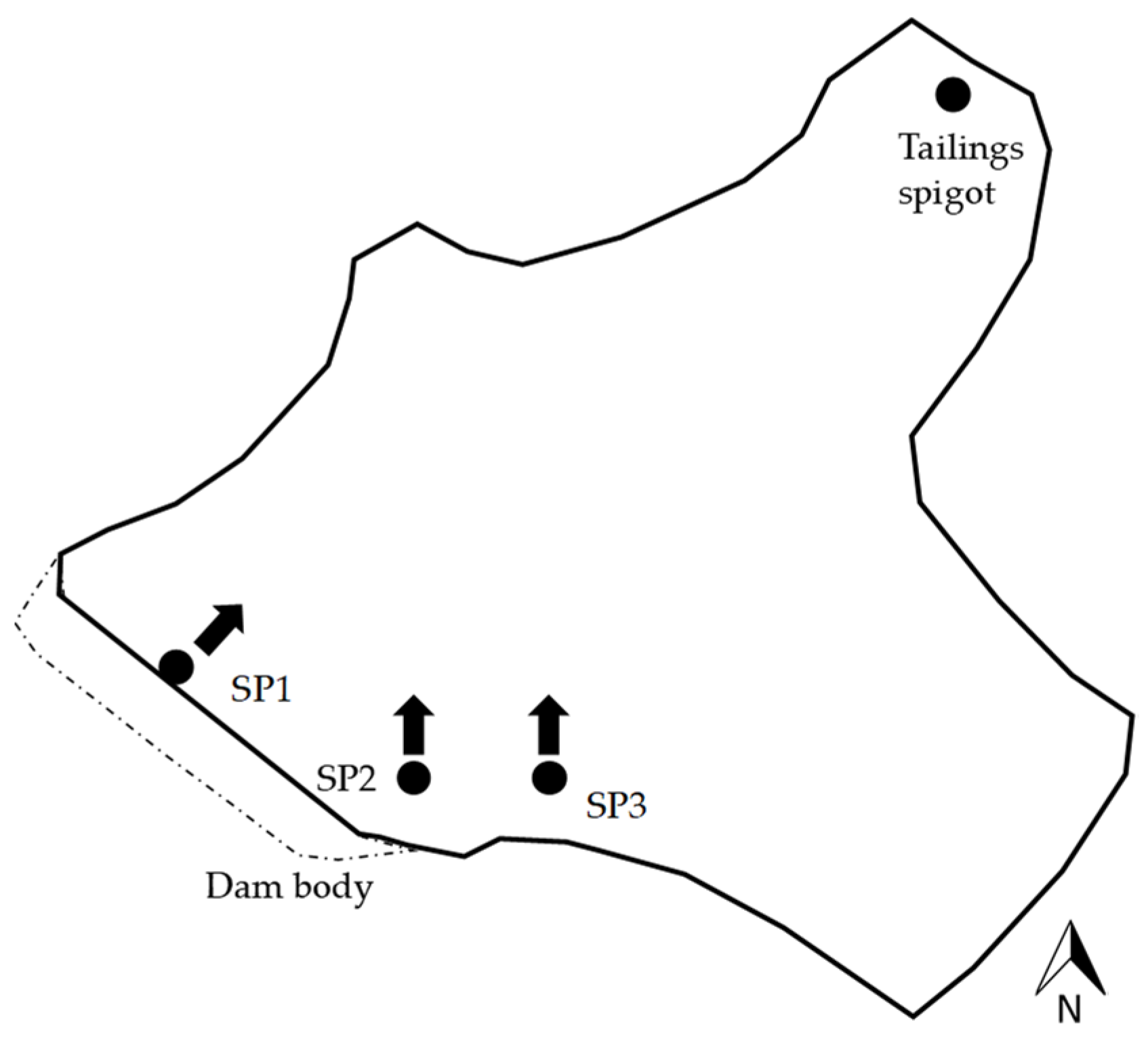
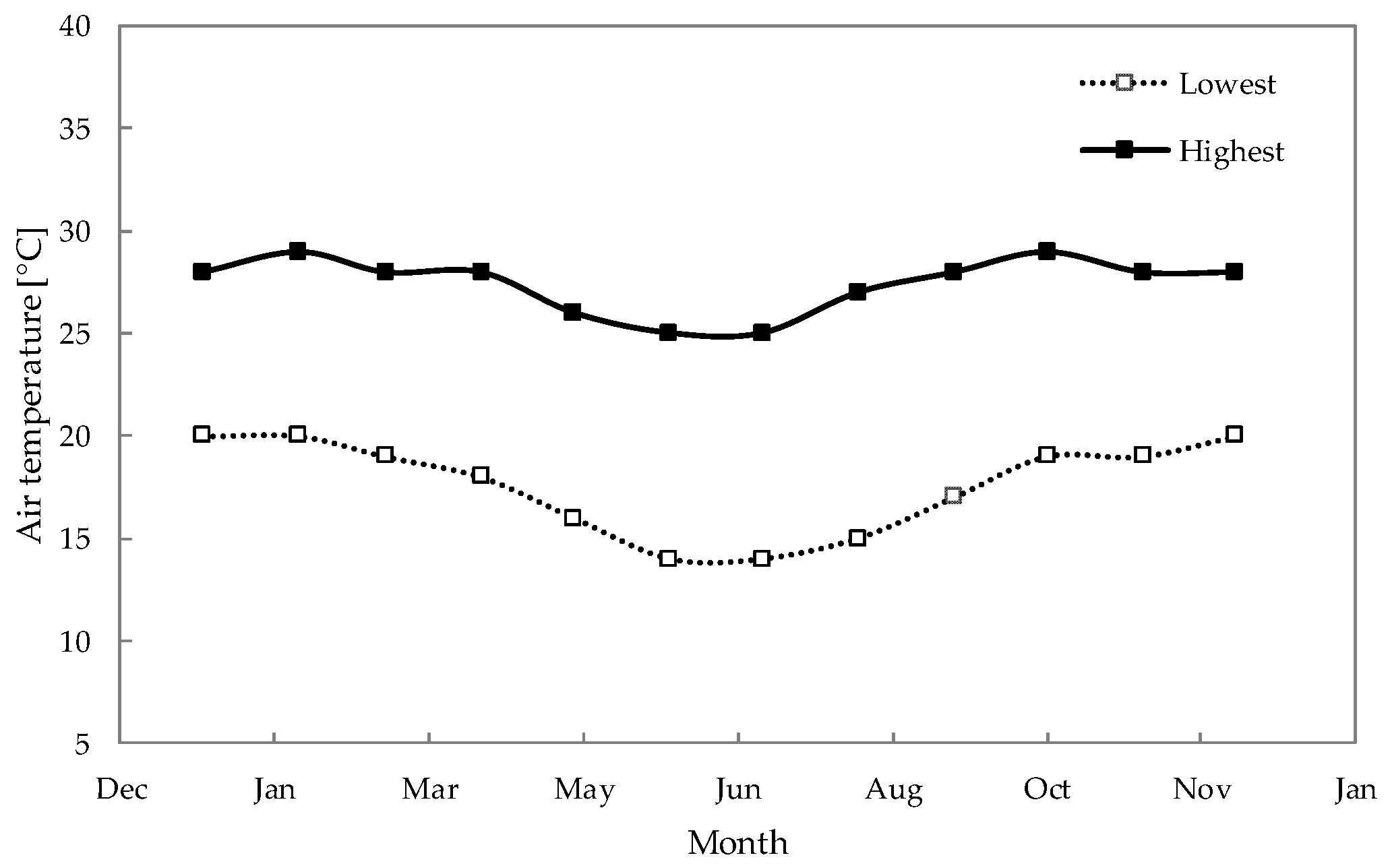

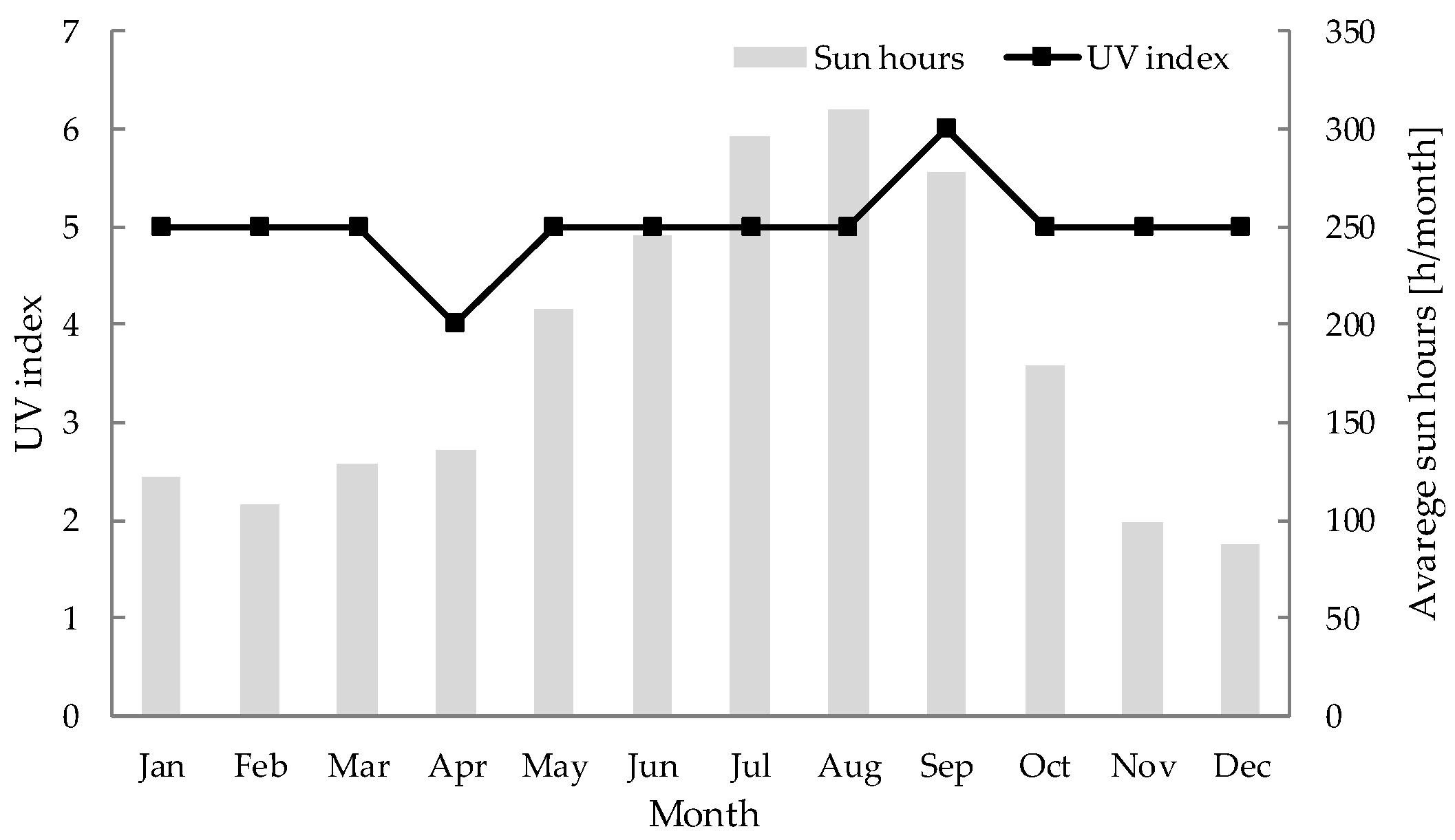
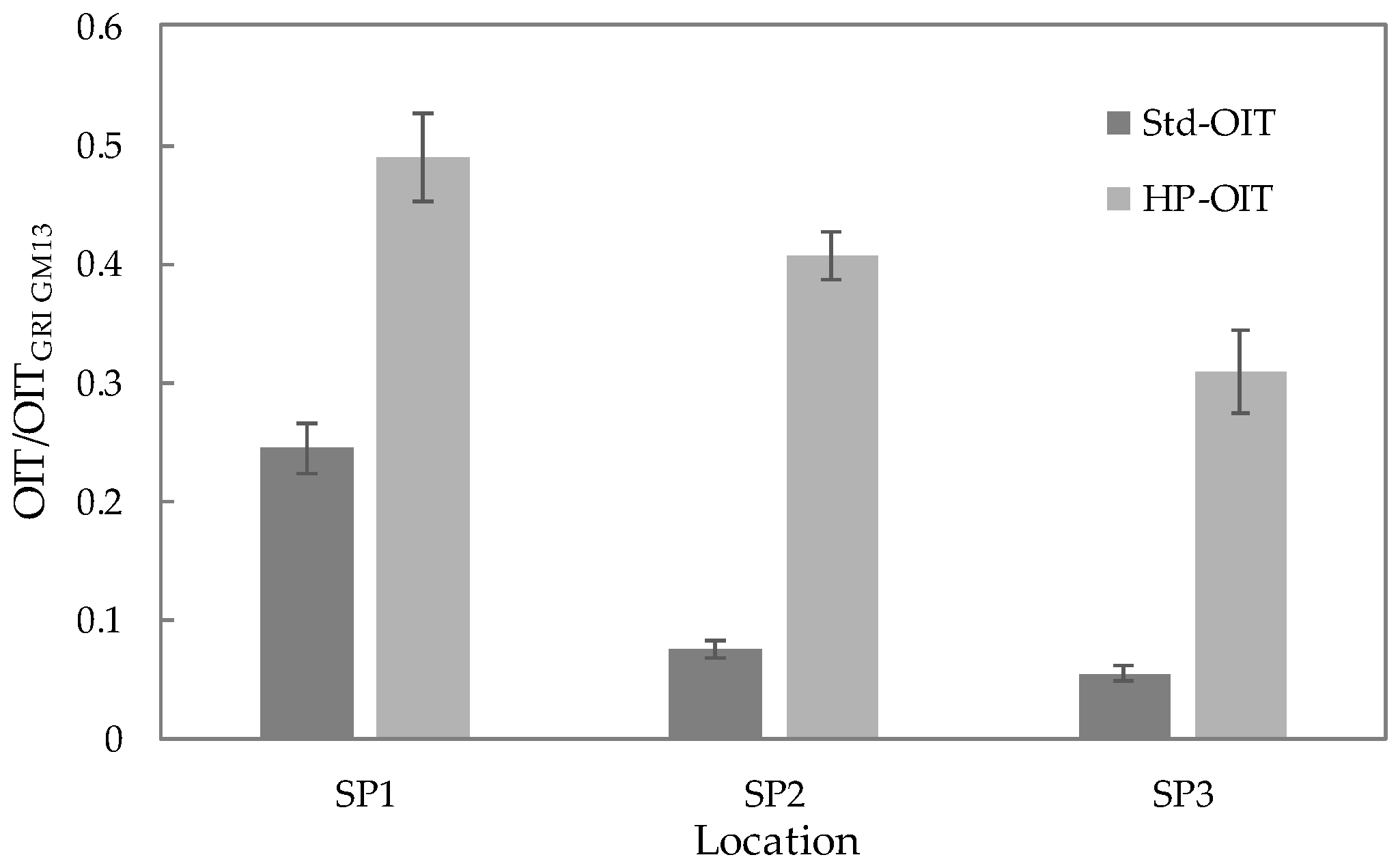
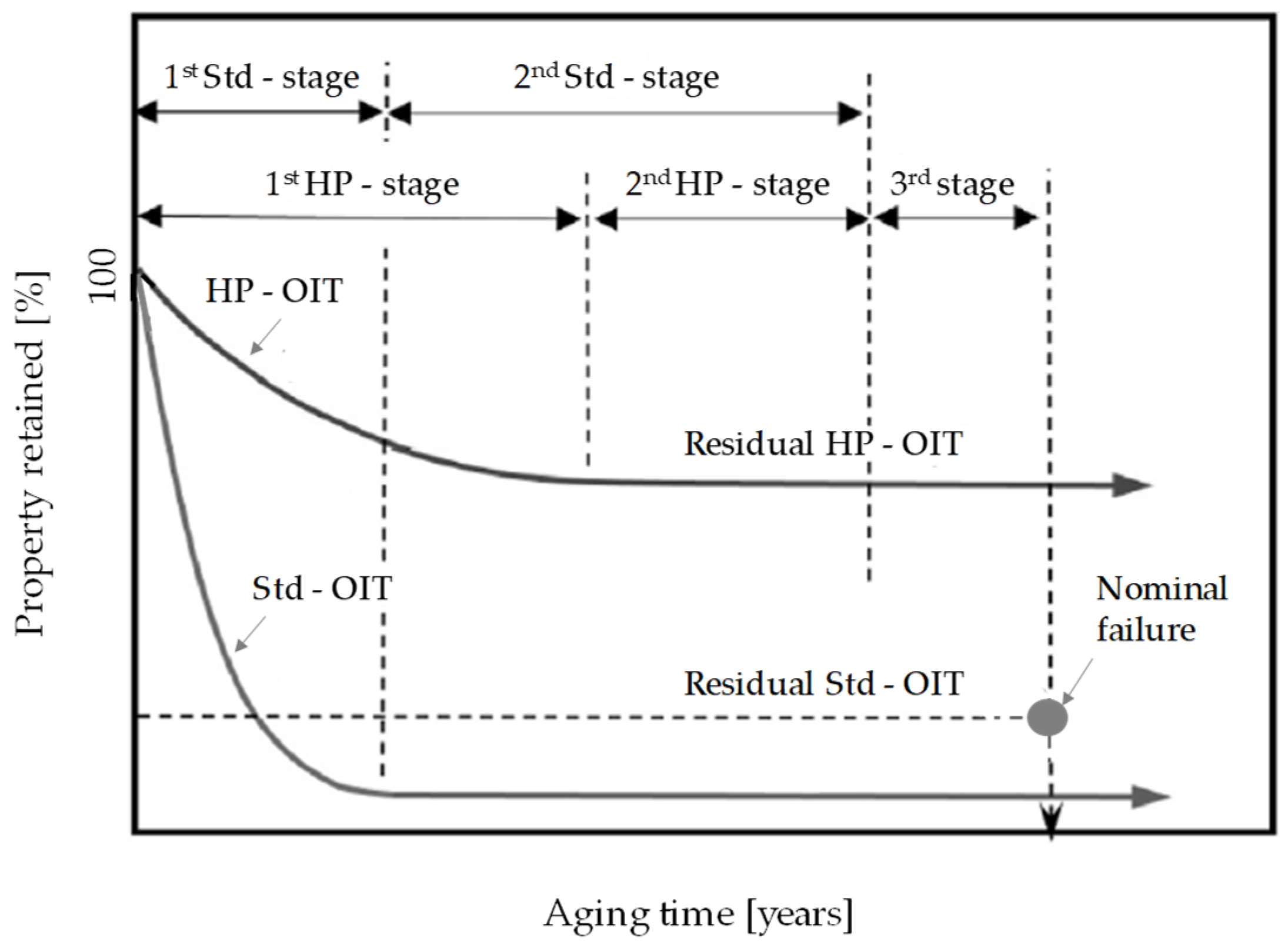

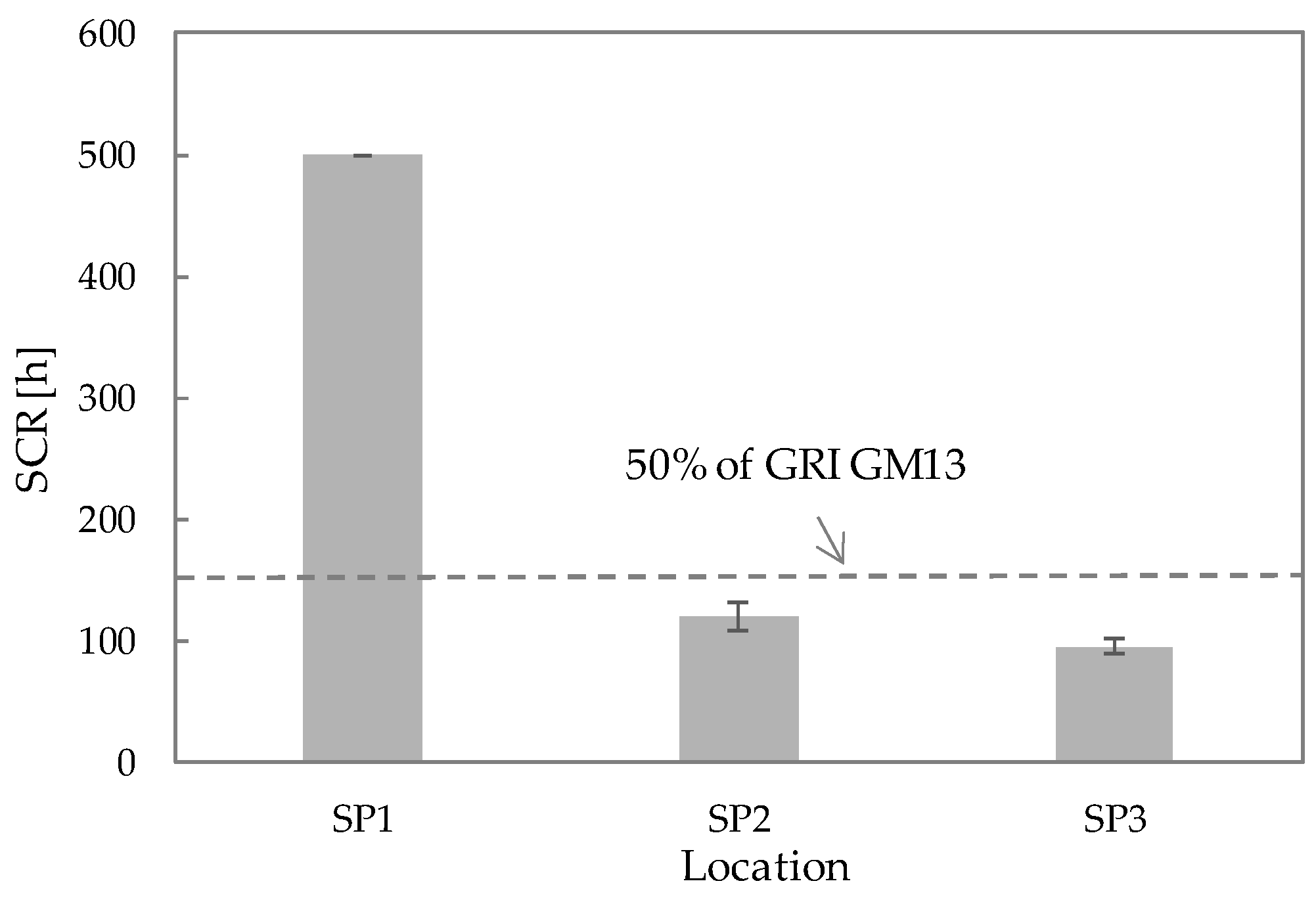
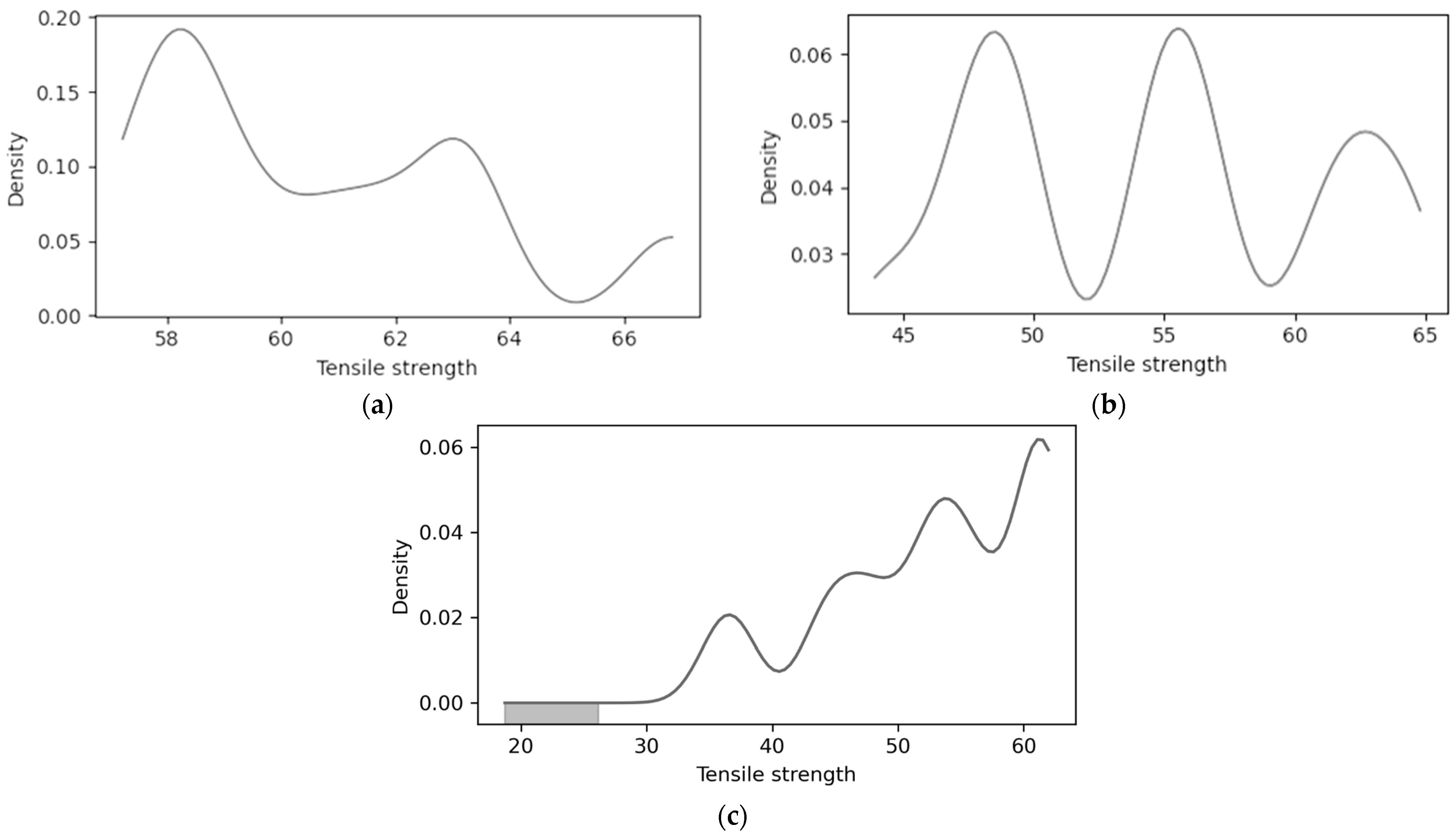

| Parameter | Value | Unit | Maximum Limits |
|---|---|---|---|
| Arsenic | 5.93 | mg/L | 0.01 |
| Cyanide | 0.074 | mg/L | 0.07 |
| Iron | 3.39 | mg/L | 0.30 |
| Sulfate | 607 | mg/L | 250 |
| Solubilized pH | 8.55 | - | - |
| Parameter | SP1 | SP2 | SP3 | GRI GM13 |
|---|---|---|---|---|
| Density [g/cm3] | 0.948 (1.1 × 10−5%) (1) | 0.954 (1.6 × 10−5%) | 0.939 (9.6 × 10−6%) | 0.940 |
| Thickness [mm] | 2.05 (1.3%) | 1.87 (3.4%) | 1.88 (1.6%) | 2.00 |
| Tensile strength—yield [kN/m] | 39.4 (3.6%) | 41.2 (4.5%) | 41.9 (2.4%) | 29.0 |
| Tensile strength—break [kN/m] | 59.6 (8.0%) | 54.5 (12.9%) | 49.4 (27.3%) | 53.0 |
| Tensile strain—yield [%] | 16.0 (5.3%) | 17.8 (4.1%) | 16.2 (3.2%) | 12.0 |
| Tensile strain—break [%] | 789.8 (7.9%) | 748.4 (10.7%) | 686.7 (20.8%) | 700.0 |
| Tear resistance [N] | 316.3 (7.9%) | 323.6 (3.5%) | 326.3 (1.5%) | 249.0 |
| Puncture resistance [N] | 878.4 (1.4%) | 839.1 (4.6%) | 847.9 (3.2%) | 640.0 |
| Carbon black content [%] | 2.4 (14.8%) | 2.9 (8.9%) | 2.9 (8.2%) | 2.0–3.0 |
| Dispersion of carbon black | Category 1 | Category 1 | Category 1 | (2) |
| SCR [h] | 500 (3) | 120 (9.1%) | 95 (6.6%) | 300 (4) |
| Std-OIT [min] | 24.5 (8.6%) | 7.5 (9.5%) | 5.5 (12.9%) | 100 |
| HP-OIT [min] | 195.7 (7.7%) | 162.8 (5.1%) | 123.5 (11.5%) | 400 |
| Parameter | SP2 | GRI GM19a |
|---|---|---|
| Shear strength [N/mm] (1) | 47.3 (2.1%) | 28.0 |
| Shear elongation at break [%] | 95.5 (41.9%) | 50.0 |
| Peel strength—weld A [N/mm] (2) | 24.5 (18.1%) | 21.2 |
| Peel strength—weld B [N/mm] | 29.3 (11.0%) | |
| Peel separation—weld A [%] | 56.0 (49.0%) | 25.0 |
| Peel separation—weld B [%] | 56.8 (12.2%) |
Disclaimer/Publisher’s Note: The statements, opinions and data contained in all publications are solely those of the individual author(s) and contributor(s) and not of MDPI and/or the editor(s). MDPI and/or the editor(s) disclaim responsibility for any injury to people or property resulting from any ideas, methods, instructions or products referred to in the content. |
© 2024 by the authors. Licensee MDPI, Basel, Switzerland. This article is an open access article distributed under the terms and conditions of the Creative Commons Attribution (CC BY) license (https://creativecommons.org/licenses/by/4.0/).
Share and Cite
Urashima, B.M.C.; Santos, R.; Ferreira, L.D.; Inui, T.; Urashima, D.C.; Duarte, A.R. The Long-Term Performance of a High-Density Polyethylene Geomembrane with Non-Parametric Statistic Analysis and Its Contribution to the Sustainable Development Goals. Appl. Sci. 2024, 14, 6821. https://doi.org/10.3390/app14156821
Urashima BMC, Santos R, Ferreira LD, Inui T, Urashima DC, Duarte AR. The Long-Term Performance of a High-Density Polyethylene Geomembrane with Non-Parametric Statistic Analysis and Its Contribution to the Sustainable Development Goals. Applied Sciences. 2024; 14(15):6821. https://doi.org/10.3390/app14156821
Chicago/Turabian StyleUrashima, Beatriz M. C., Renato Santos, Lucas D. Ferreira, Toru Inui, Denise C. Urashima, and Anderson R. Duarte. 2024. "The Long-Term Performance of a High-Density Polyethylene Geomembrane with Non-Parametric Statistic Analysis and Its Contribution to the Sustainable Development Goals" Applied Sciences 14, no. 15: 6821. https://doi.org/10.3390/app14156821
APA StyleUrashima, B. M. C., Santos, R., Ferreira, L. D., Inui, T., Urashima, D. C., & Duarte, A. R. (2024). The Long-Term Performance of a High-Density Polyethylene Geomembrane with Non-Parametric Statistic Analysis and Its Contribution to the Sustainable Development Goals. Applied Sciences, 14(15), 6821. https://doi.org/10.3390/app14156821







